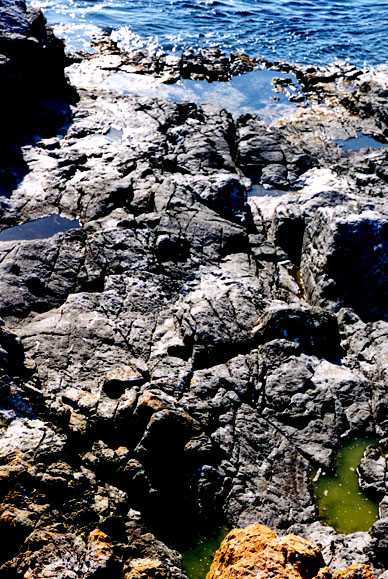This pool is one of the most highly elevated pools in the peg six area of Race Rocks. It has a south-westerly aspect, is relatively shallow (its maximum depth being nine cms). It is also fairly small, having an area of just 0.36 square metres, and a perimeter of 0.39 metres.
At certain times of the year, pool # eight is literally packed with life! Within its confines we were able to locate filamentous diatoms (a brown-gold, highly productive microscopic organism), small barnacles, and red harpacticoids..
On the day of our observations (in late April 2000) we found that the surface temperature was 13.5 degrees Celsius and a temperature at the deepest point 11.0 degrees Celsius. At 5cm, we recorded a temperature of 12.0cm. This is what we would have expected, because the temperature is affected by the heating effect of the sun, and the water forms stratified layers of temperature. These temperatures will vary with the season and time of day. In this relatively small pool, one would expect a large temperature range which will create a large variation in the life-cycles within the pool, changing as the seasons change. For organisms with a longer life-cycle, it will be necessary to have the ability to adapt to a high temperature range.
As temperature decreased as the pool became deeper, we observed the opposite effect with regard to salininty. At the surface, for example, a salinity of 13.5 parts per thousand was recorded, and at the depths, a salinity of 16.5 parts per thousand was found. This is fairly typical of a small, brackish pool in the inter-tidal zone. This is another example of stratification and this variation creates differences in productivity and affect. So we could day that this small pool on this particular day had both a halocline and a thermocline.
(Adapted from a student’s lab write up, 2000)
Some ideas to consider:
Tidepools 7and 8 are very close together, varying only a few cm in elevation. The salinity and temperatures of the pools may vary however. It might be worthwhile to document these variations and propose some explanations for the variation.

